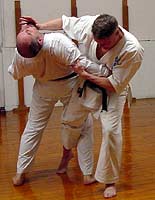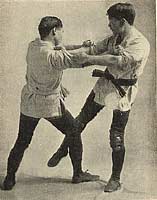The O-Soto-Gari Judo Throw In Jujutsu & Karate
by Christopher Caile

Editor's Note: This article
is a companion piece to the two previous articles on "The Classical
O-Soto-Gari Judo Throw." Part I of this series discussed why the
author didn't think the throw worked as it was traditionally taught.
Part II is a rebuttal of that view. This article will provide an historic
overview of the throws roots in jujutsu and other combative arts and
compare the throw's execution in these arts to that performed in judo.
Introduction
O-soto-gari is one of the most basic throws in judo. It is important
to remember that the throw had its genesis in combat and self-defense
related systems. In judo, which derived out of earlier self-defense
oriented jujutsu systems, the throw evolved into a technique set up
by off-balancing and body control. (1)
The focus is on the setting up and execution of the throw itself.
In jujutsu, aikijujutsu, karate and many other combat oriented systems,
the throw is only part of a multi-part technique. An attack is first
countered, nullified, or avoided. A counter attack often follows. This
leads up to the execution of the throw itself, which is often followed
by a secondary (to the impact of the throw) finishing technique.
To help illustrate the historic context of the modern judo o-soto-gari
throw, this article will demonstrate a few empty hand jujutsu combinations
that employ this technique as well as a daito-ryu example of how this
technique was used in combat against an attack from a short sword. Several
karate examples will also be illustrated. (2)
This article attempts to provide the reader with a historic conceptual
understanding of the roots of this technique rather than attemption
to catalog its many possiblities.
Kano's Original Jui-Jitsu (Judo)
Judo was developed by Jigoro Kano in 1882 as a synthesis of several
earlier jujutsu (jui-jitsu) systems that were modified over time for
the competition environment seen today. When first developed, however,
the art was very different from what is practiced today. In the early
days of judo (from its inception and for the next 20 years or so) it
faced stiff competition from traditional jujutsu systems and a number
of challenge "no-holds barred" matches were held.
In 1924 the Kano system of jui jitsu or judo was presented (with a
few additions) in a book, "The Complete Kano Jui-Jitsu," authored
by H. Irving Hancock and Katsukuma Higashi. The authors explained that
the book was the first authentic work to explain the art as practiced
in
 Japan. Several o-soto-gari like techniques are presented. The book explains
that, in the above photo, an assailant has grabbed your upper right
arm with his left hand while also grabbing your left - thus a two arm
grab in preparation for a secondary technique (such as a throw as would
be found in modern judo). Here the defender pulls the assailant's right
arm toward himself (forcing him to advance with his right foot) while
stepping back on the left foot. Then while pressing the right hand on
the assailant's right shoulder the defendent uses the right leg to "kick
the back" of the adversary's left knee with the back of the right
calf while pulling with left arm and pushing with the right -- this
will throw him.
Japan. Several o-soto-gari like techniques are presented. The book explains
that, in the above photo, an assailant has grabbed your upper right
arm with his left hand while also grabbing your left - thus a two arm
grab in preparation for a secondary technique (such as a throw as would
be found in modern judo). Here the defender pulls the assailant's right
arm toward himself (forcing him to advance with his right foot) while
stepping back on the left foot. Then while pressing the right hand on
the assailant's right shoulder the defendent uses the right leg to "kick
the back" of the adversary's left knee with the back of the right
calf while pulling with left arm and pushing with the right -- this
will throw him.
Notice here the authors say kick rather than sweep. Early execution
of this type of technique used a kicking motion rather than a sweep
of the leg as is practiced today. This will be illustrated in more detail
below in an example from Daito-ryu.
In this application if an opponent grabs around the waist, the defender
is advised to use his right hand to "throw off" the attackers
left arm with the right elbow, grab around the attacker's neck with
the right arm and secure it with a grip on the attacker's uniform lapel.
The right hand seize the opponent's left elbow.
In the second photo the defender kicks the back of the assailant's
left knee forcing him backward to the position seen in the thirdphoto.
With a headlock in place the defender uses the left arm to seize his
own left wrist -- and tighten the "V" lock on the attacker's
neck to put pressure on the front of the neck (The book notes that this
technique can break the opponent's neck). In modern judo a necklock
is usually performed against the side of an opponent's neck (cutting
off blood flow to cause temporary unconsciousness). The more dangerous
type of windpipe technique shown here is discouraged today in order
to avoid injury (See an article on this subject, "The
Judo Choke").
The essential point here is that in these jujutsu techniques, the defender
isn't competing to throw a skilled opponent as in modern judo, but is
responding to an attack, the attacker usually not having any knowledge
of jujutsu techniques. In addition a lot more than unbalancing is involved.
This is further illustrated in another jujutsu technique illustrated
below.
This example is a simple jujutsu defense against a choke in which the
hands are clenched or held together and thrust upward against the assailant's
arms to dislodge the attack (the fingers can also be opened and directed
to also attack the eyes- not shown). Then the defender wraps his left
arm around (and pulls) the attacker's right elbow while using his right
palm as a strike/push upward (and back) against the attacker's chin.
At the same time the defender steps forward at an angle to his left
which forces the assailant's weight onto his right leg while the push/pull
action forces the attacker's body to arch backward. In the final photo
the throw is executed.
Here the defender is doing a lot more than just off-balancing. The
defender attacks and stuns the assailant with a counter attack while
also off balancing him.
In many jujutsu techniques, strikes (atemi) or kicks are used not to
severely hurt or knock out an opponent, but to stun, distract or make
the assailant react (flinch). Thus they are used to set up the jujutsu
technique, a component of which can be a throw.
(Continued)
Footnotes:
(1) Jigoro Kano (1860-1938) developed his own
synthesis of several jujutsu systems called kodokan judo -- principally
from Tenjin shinyo ryu jujitsu which specialized in striking and grappling
techniques and kito ryu which emphasized throwing techniques. The new
art eliminated many of jujutsu's most dangerious techniques. Such things
as atemi. or the arm of striking is only taught at higher levels, while
certain methods of throwing, joint manipulations and specific self-defense
counters have been eliminated. Today Judo focused on the pure aspects
of throwing and grappling so students can practice and compete safely.
(2) Only a few of the literally thousands of
possible applications drawn from jujutsu, daito-ryu, other aikijujtsu
systems, karate and other combat dicplines could be illustrated here.